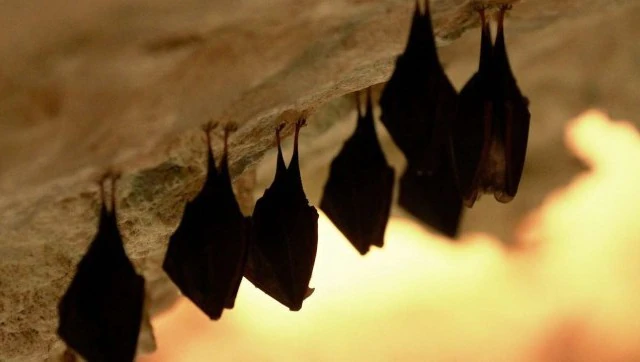Nipah virus: What is it and how is it spread
Nipah virus or (NiV), which was first identified during an outbreak in Kampung Sungai Nipah, Malaysia in 1998, is primarily a zoonotic disease carried by fruit bats of the Pteropodidae family
Indian state of Kerala, which has seen a previous outbreak of Nipah virus in 2018 and stray cases going back to as far as 2001, has again reported a case on Sunday. The patient, a 12-year-old boy, passed away hours after his reports confirmed that his symptoms were because of the NiV infection.
He had recently recovered from COVID-19 but was admitted to a hospital on 1 September for a relentless high fever and breathing difficulties. The government has said that his close contacts have been traced and isolated, and all of them remain symptom-free. However, it is still advisable to stay cautious because the state’s health infrastructure is already burdened in dealing with one pandemic, and a localised endemic could make matters worse.
Moreover, Nipah is known to have been dangerous and because the early symptoms are very similar to that of the novel coronavirus , it is important to stay alert. Here are key points about the disease to help you stay informed.
What is Nipah Virus?
Nipah virus or (NiV), which was first identified during an outbreak in Kampung Sungai Nipah, Malaysia in 1998, is primarily a zoonotic disease carried by fruit bats of the Pteropodidae family.
Scientists say that viruses like Nipah could have co-existed with the bats in India for a long time only to be pushed out of the mammal in adverse circumstances.
“Viruses like Nipah have always been in the system of fruit bats. They have co-evolved for years. Such a disease becomes virulent when there is a stress on the animal. Such stress could be because of a loss of habitat, or not getting sufficient food for survival. So, when the animal is faced with such stress, it tends to expel these viruses. In other words, the virus tends to move out of animal. This could be what happened in Kozhikode,” Dr Nameer PO had told Firstpost during the previous outbreak.
What are the symptoms?
Infection with the Nipah virus can cause mild to severe disease, including swelling of the brain (encephalitis) and potentially death.
Symptoms typically appear in 4-14 days following exposure to the virus. It often includes signs of respiratory illness, such as cough, sore throat, and difficulty breathing. A phase of brain swelling (encephalitis) may follow, where symptoms can include drowsiness, disorientation, and mental confusion, which can rapidly progress to coma within 24-48 hours.
Long-term side effects in survivors of Nipah virus infection have been noted, including persistent convulsions and personality changes.
Infections that lead to symptoms and sometimes death much later after exposure (known as dormant or latent infections) have also been reported months and even years after exposure, the US CDC said.
5 precautions to keep yourself safe
Here are five things you can do to keep yourself safe.
- AVOID touching animals you don’t know and love
What if you absolutely need to touch a sick animal? Wear gloves and other protective clothing to handle the animals, their meat or body tissue, says the World Health Organisation (WHO).
- AVOID buying fruits that are wrinkled, bitted or damaged in any way
That said, the risk can be eliminated by washing the fruit thoroughly and peeling them before consumption. Fruit with signs of bat bites should be discarded. Freshly collected date palm juice should be boiled.
- AVOID drinking anything fermented or stored in the open/under palm trees
In Bangladesh and India, where Nipah infections are more frequent than anywhere else, exposure is linked to consuming raw date palm sap and contact with bats. Infrared cameras have caught bats licking the sap before they were collected and consumed by locals. Many of us probably live far from the cooling comfort of coconut/palm trees or a Batcave. But bats are still out and about in cities, so are pigs.
- AVOID touching anybody infected with the virus or their things
What if you need to attend to someone that you think is Nipah positive? Protect yourself from direct contact using gloves, a mask and protective clothing. Regular hand washes are a must after caring for or visiting a Nipah victim.
- SEEK early medical attention
If you reside in an area where known cases of Nipah virus exist, it is important to isolate yourself and report to authorities if you feel sick even with mild symptoms. This helps authorities to get you treatment faster, and also control the spread of the infection.
Is there a vaccine?
A vaccine has been in development in preclinical development since 2012 and it is currently in clinical development as an emergency vaccine countermeasure for Nipah virus outbreaks. The current formula under works is said to have shown promising results in preventing Nipah and Hendra virus infection.
Treatment options
According to the WHO, “There are currently no drugs specific for Nipah virus infection… treatment is limited to supportive care, including rest, hydration, and treatment of symptoms as they occur. Intensive supportive care is recommended to treat severe respiratory and neurologic complications.”
How did Nipah spread during previous outbreaks?
The US Centre for Disease Control states that Nipah virus, originally a zoonotic disease, originates in animals but can spread to humans when they come in contact with infected species. It’s modern-day-transmission is recorded to have happened in the following three ways:
- Direct contact with infected animals, such as bats or pigs, or their body fluids (such as blood, urine or saliva)
- Consuming food products that have been contaminated by body fluids of infected animals (such as palm sap or fruit contaminated by an infected bat)
- Close contact with a person infected with NiV or their body fluids (including nasal or respiratory droplets, urine, or blood)
However, the origin could not be traced with certainty always.
Kerala’s 2018 localised endemic, in which 17 people lost their lives, started when a 23-year-old male in Kerala’s Kozhikode consumed a fruit partially eaten by a bat.
The first-ever outbreak of the virus in Malaysia’s Nipah village in 1998, had claimed five lives. Here, pigs had contracted the disease first, from where it was transmitted to farmers.
Several people had lost their lives to Nipah in Bangladesh in 2004 after consuming date palm saps contaminated by fruit bats and there were a few other outbreaks in and around the region. In 2006, the virus had raised concerns in Siliguri, West Bengal, a state where the first case had been detected as early as 2001. But most of these cases were said to have resulted from human to human contact.
Inputs from agencies




